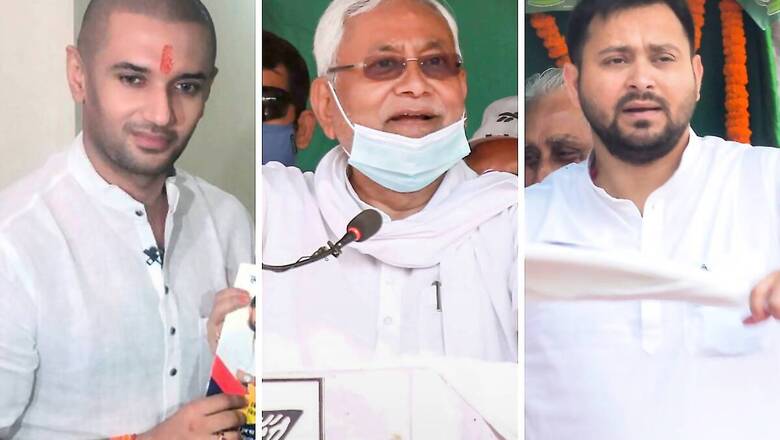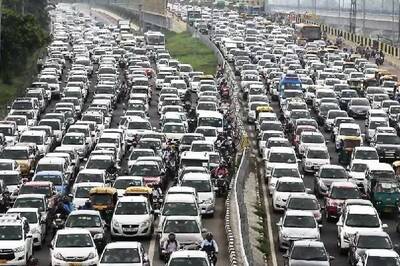
views
Till September it was widely believed that the NDA was going to hold on to Bihar comfortably. Lalu Yadav was still in jail, the RLSP of Upendra Kushwaha had fallen apart, and Tejashwi Yadav with the baggage of the 2019 defeat on his shoulders did not look like the challenger who could dislodge the formidable combination of BJP-JD(U) which had been winning election after election together, barring 2015 one.
However, the ground was full of discontent with Nitish Kumar’s third term amid rising inflation, unemployment and massive corruption and this was evident from the first rally of Tejashwi Yadav which attracted an unexpectedly huge crowd, defying Covid-19 guidelines. Soon that became the norm with massive gatherings of mostly youths echoing the call of the young RJD leader on employment in every rally he attended.
This impressive turnout in his rallies sent the first signals of worry to the NDA camp which was flirting with the idea of having Chirag Paswan officially with some friendly triangular fights in order to keep him in the fold. After seeing the crowds in Tejashwi’s public meetings, Chirag too toughened his stand against Nitish Kumar, understanding that on the ground the chief minister had become a liability.
Around the time all this was happening, the RJD announced its alliance by giving 70 seats to the Congress and in the process it forced the Vikassheel Insaan Party (VIP), which has support among the Nishad-Mallah OBC groups that have a sizable presence in central and north Bihar, to leave the alliance. The RJD led by Tejashwi was swayed by the idea of securing some upper caste support through the unemployment issue and through Congress candidates and it did not weigh enough the VIP’s importance in the alliance. The results have shown that in north and central Bihar, this mistake cost the Grand Alliance dear.
Still, everything was going fine and as per the script for the Tejashwi-led alliance. The crowds in his rallies were getting bigger and bigger. And then came the first phase of voting which had many seats where the CPI(ML) had strengthened the Mahagathbandhan by being a part of it. The real rich vs poor narrative was at play in the opening round. It is this phase where the LJP of Chirag Paswan fielded many big BJP leaders as its nominee, unsettling the equations of the JD(U).
The first phase voting took place on the south of the Ganges and it was clear during voting that there was no coordination between constituents of the NDA, mainly the BJP and the JD(U), whereas the MGB constituents, Left Parties, Congress and RJD, were seen to be fighting the election in a more synchronised manner. The results of the first phase seats too confirm the findings of the voting day surveys and the NDA mainly lost JD(U) seats while saving some BJP seats which also took a hit because of a wave sort of voting taking place in the area. The following seats are mentioned for the margin of victory to understand the wave prevailing in favour of the MGB in the first phase—
Sandesh: RJD secured 51.54% votes and won by 51 thousand votes, defeating JD(U); LJP was in the fray too.
Bikram: Congress secured 47.71% votes and defeated BJP rebel by 36,000 votes. BJP lost its deposit here.
Agiaon: CPI(ML) secured 61.39% votes and defeated JD(U) by 48,000 votes. Here LJP was no factor as it secured only 3.54% votes.
Paliganj: CPI(ML) won with 44% votes whereas JD(U) and LJP both polled 34% votes together.
Tarari: CPI(ML) won with 44% votes whereas BJP rebel gave a tough fight with 37% votes and BJP lost its deposit.
Shahpur: Here again CPI(ML) won with 41% votes and 15% margin from a BJP rebel whereas BJP candidate lost deposit.
Another seat of the same cluster though went for polls in the second phase and saw RJD emerge victorious.
Maner: This is an eye-opener seat as in a direct contest between RJD and BJP, RJD won with a huge margin of 33,000 votes. Here LJP did not contest. No ‘vote katwa’ was there either, yet RJD secured almost 48% votes.
Now interestingly, none of the Prime Minister’s charm could save the deposit of three official candidates in the above seats which is said to have worked in the second and third phase of the election.
There are two seats in same cluster which were won by the BJP—
Aarah: Here incumbent Muslim MLA of RJD was dropped to accommodate an Ansari Muslim of CPI(ML). But despite winning all the seats nearby, the CPI(ML) lost this seat to the BJP by an almost 2% margin. It was a sign of polarisation which prevailed in the later phases.
Barhara : Here an old RJD man, a Rajput and three-term MLA, contested from BJP and defeated RJD’s Yadav candidate purely on his own skill and contacts.
Second phase
There were hardly 5 days between the first phase of voting and the second phase, whereas 8 days separated the first and third phase. Yet the voting pattern and the results have shown a remarkable difference from the first phase. There could be many reasons for this, one is the realisation of NDA constituents to dump LJP as it was not winning any seats and was just playing spoilsport. The top BJP leadership became more vocal against Chirag Paswan after the first phase. The clear wave in favour of the Mahagathbandhan sensed by Muslim voters resulted in a dropping of guard of tactical voting which resulted in deviation of minority votes in many seats and ultimately cost the MGB, and the total number of Muslim MLAs too dropped from 24 the last time to 19 this time. The following seats are examples of this:
Bhorey: This second phase seat saw a thin victory margin of 0.25% (1,026 votes) in favour of JD(U) as CPI(ML) of MGB lost and its demand of recounting was denied. What is important to note is that LJP could get only 2.47% votes, making almost no impact on the outcome. The BJP clearly transferred its votes to JD(U) here.
Pranpur: Tauquir Alam of Congress lost this seat by a small margin of 1.5% votes against BJP, while a Muslim independent candidate Isharat Parveen secured almost 10% of the votes who was in fact runner-up in the 2015 election.
Beldaur: This is in Khagaria district and here the sitting JD(U) MLA won despite getting only 32% votes as the Congress’s Chandan Yadav could get only 29% votes with LJP’s Mithilesh Nishad, who was second last time, securing almost 18% of votes. Clearly, here LJP damaged MGB more than the NDA candidate.
Khagaria: The Khagaria election was a replica of Beldaur, as the RJD managed to win with only 31% votes by a thin margin of 2% over JD(U). Here LJP polled fewer votes than Beldaur and ended up with just 14% votes with another 8% going to Pappu Yadav’s party.
Danapur: Ritlal Ray (Yadav) of RJD was able to defeat a woman candidate of BJP whose husband’s murder was attributed to him. The margin was also significant with 16,000 votes, thus negating the ‘jungle raj’ argument and that it could have swung the election in the last two phases.
Gopalpur: This seat is a stronghold of sitting JD(U) MLA Narendra Kumar Niraj who has been winning here since 2005, coinciding with the formation of Nitish Kumar’s government. In 2015 his winning margin was just 3% when he contested against BJP, but this year he won with a margin of 15% which clearly shows that BJP transferred its vote to him. This is confirmed again by the fact that LJP got 14% votes and actually damaged RJD’s chances more.
Third phase
The third phase saw more inclination to vote for BJP as compared to the first two phases and JD(U) too gained from the momentum.
East and West Champaran in any case is a stronghold of the BJP and it won more seats even in 2015 over there. This time again the area allowed it a big haul. However, the real surprise came from Seemanchal where out of 24 seats, NDA bagged 12 while MGB could get only 7, and 5 seats went to AIMIM.
CASCADING EFFECT OF AGGRESSIVE CAMPAIGNING OF AIMIM
The AIMIM ran an aggressive Muslim-issues-centric campaign in the entire Seemanchal region which has 24 assembly seats in core and another 20 in buffer area. Araraiya, Kishanganj, Purnia and Katihar Lok Sabha seats fully fall in Seemanchal. The Muslim population here is more than 40%. The AIMIM campaign contained hot topics of the central government like CAA/NRC. Nitish Kumar himself has voiced opposition to these issues in Bihar under his watch. Because of AIMIM, the focus of this election shifted from Nitish’s non performance to these contentious issues which ultimately helped the BJP’s polarisation plank. This affected the entire third phase through extensive coverage by media. Here’s what happened next:
Assembly segments under Araria Lok Sabha seat (45% Muslim Votes)
-Narpatganj BJP won by getting almost 50% votes
-Raniganj (SC) JD(U) picked up 44% votes and won with 1.5% margin
-Forbesganj BJP won with almost 50% votes
-Araria Congress victorious with 54% votes
-Jokihat MIM won with 34% votes, RJD got 30%, BJP got 28%
-Sikti BJP won with 47% votes
Assembly segments under Purnea Lok Sabha seat (35% Muslim votes)
-Kasba Congress won with 41% votes. NDA left this seat to HAM-S which third and LJP was second
-Banmankhi BJP won with 52% votes
-Rupauli JD(U) victorious with 35% votes as CPI couldn’t hold on and conceded LJP the second position
-Dhamdaha JD(U) won with 48% votes with full support of BJP, against RJD’s 32%
-Purnia BJP secured victory with 53% votes against Congress’s 36%
-Korha Congress lost its traditional seat after 3 wins; BJP secured 53% votes against Congress’s 39%
Assembly segments under Katihar Lok Sabha seat (40% Muslim votes)
-Katihar BJP secured victory with almost 49% votes that proved too much compared to RJD’s 43%
-Kadwa Congress won with 42% votes as JD(U) and LJP split each other’s votes
-Balrampur Here CPI(ML) secured 51% votes, defeating the VIP candidate by a handsome margin
-Pranpur Vote division among minority candidates led to BJP victory with 39% votes
-Manihari Congress won this seat comfortably with LJP playing spoilsport for JD(U)
-Barari JD(U) secured 45% votes and a comfortable victory over RJD’s 39% votes
Assembly segments under Kishanganj Lok Sabha seat (70% Muslim votes)
-Bahadurganj: AIMIM won this seat with almost 50% votes
-Thakurganj: This seat is a classic example of Hindu-Muslim polarisation as JD(U) candidate was a Muslim and so was LJP’s besides AIMIM. One independent candidate Gopal Agrawal bagged 56,000 or 29% votes and came second. RJD’s Muslim candidate won this seat
-Kishanganj: It has an almost 70% Muslim population and yet a BJP candidate lost by a small margin of 0.8% votes to the Congress as the AIMIM almost allowed the BJP to sneak through
-Kochadhaman: AIMIM secured almost 50% of votes as RJD came a poor third. JD(U) and LJP too fielded Muslims
-Amour: Here again AIMIM secured almost 50% of votes as Congress came third. JD(U) fielded a Muslim candidate as well who lost
-Baisi: AIMIM bagged this seat in a three-corner contest as RJD came third with BJP second
The real drama occurred in buffer areas of both second and third phase—Mithilanchal to Anga Pradesh all affected.
Besides the aforementioned 4 Lok Sabha seats where Muslim Population is 35 to 70%, the eight Lok Sabha, seats namely Bhagalpur, Supaul, Madhepura, Khagaria, Darbhanga, Jhanjharpur, Madhubani and Samastipur spread from Anga Pradesh to Mithilanchal but close enough to Seemanchal region by either sharing boundaries with any of those four Lok Sabha seats or just the connected seat having a demography where Muslim population is 15 to 25%, bore the real consequences of the aggressive campaigning of AIMIM.
Madhubani Lok Sabha seat, where Muslim population is about 26%, gave the worst result for the MGB with none of its candidates able to win whereas NDA got all 6. In Jhanjharpur, Madhepura, despite being a Yadav-dominated area, Supaul and Darbhanga, the MGB managed to win just one assembly each out of six in every Lok Sabha seat. In Madhepura, some minor effect of Pappu Yadav was also felt by MGB.
In Bhagalpur Lok Sabha region, MGB won 2 seats whereas Khagaria, another Yadav-dominated district was the only exception, which returned 4 winners for MGB. Notably this district has a less than 15% Muslim population. In Samastipur Lok Sabha constituency, MGB managed to win only 2 seats while NDA got 4.
So in 48 assembly seats of these eight Lok Sabha regions, NDA bagged 36 seats with a fabulous 75% strike rate while the MGB could get only 12. If we add all Seemanchal core area seats as well, then out of 72 assembly seats of north-central and north-east Bihar, the NDA bagged 48, the MGB got a mere 19 and 5 went to AIMIM.
So, the election was lost in this crucial area because the MGB, especially RJD, couldn’t read that the issues affecting the polls had changed drastically. Here the experience of a politician counts. Had Lalu Prasad been out or even some senior leader like Raghuvansh Prasad Singh been around to offer advice to Tejashwi, he would have read the changing script and ensured some corrective measures. Letting VIP leave the alliance was the other notable mistake besides giving 10-15 extra seats to Congress.
So it’s not the magic of women voters or the charm of Prime Minister Modi alone as postulated after the results. What worked in favour of NDA are two things. Firstly, the realisation after initial voting that damaging JD(U) through LJP would lead to a clear majority for MGB, and secondly the tried-and-tested polarisation plank which was aggravated by aggressive campaigning of AIMIM.
Read all the Latest News, Breaking News and Coronavirus News here




















Comments
0 comment